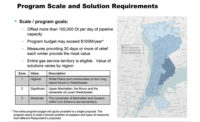One Water, also known as integrated water management, is an approach that not only helps the environment and makes a community more resilient but also helps utilities to manage their bottom line. “It’s a great tool to get rid of the things you shouldn’t be concentrating on and targeting your investment where it’s needed,” Elliott Gill, technical director of water and wastewater for CH2M, told a full session on One Water at the Water Environment Federal Technical Exhibition and Conference, in Chicago in early October. Gill was one of about eight presenters at a session that delved into everything from the modeling of One Water approaches to the politics of such an approach.
The concept of integrated water management has existed for decades. An entire water system—stormwater, flood-control, drinking-water, wastewater, groundwater and other elements affecting the water system—is viewed holistically. Denver issued its first integrated water management plan in 1997. But with less money and, in some cases, less water, more utilities are considering the One Water approach.
Drought spurred Los Angeles to adopt a One Water approach last year (ENR Nov. 7/14/16 p. 20), and New York, Atlanta, Pittsburgh, North Carolina’s Research Triangle municipalities and Richmond, Va., are among the areas that have adopted or are preparing to implement One Water.
Earlier this year, the Water Research Foundation released a “Blueprint for One Water,” developed by Brown and Caldwell to help utilities and municipalities adopt One Water.
“The challenge is that there are all of these priorities, and there’s only one pot of money,” Wendy Broley, co-principal investigator of the blueprint, told those at the One Water session. She said the key to implementing a One Water approach is “the ability to do things a little differently than you’ve always done.”
While One Water may be associated with reuse, that is not the only benefit of the approach, she said. For example, New York City has a surplus of water, but it is adopting One Water to address combined sewer outflows and make the city more resilient to sea-level rise.
Scalable
The approach, however, is scalable. Karen Jensen, an environmental analyst with the Metropolitan Council Environmental Services of Minneapolis and St. Paul, Minn., presented one early adopter of the concept: the expansion of the Empire Wastewater Treatment Plant in St. Paul. The project improved biodiversity, runoff and the community.
Jensen said the council wanted to improve the ecological management of the plant and the land surrounding it, which drained into the Vermillion River, a critical trout habitat. Among other things, the expansion reduced heat with a green roof, restored the biosolids field into a wetland and piped effluent 12 miles to the Mississippi River, bypassing the closer but more ecologically sensitive Vermillion. The line also gives the council options for reuse in the future, Jensen noted. One unexpected benefit was a $1-million state credit for developing the wetlands.
“It doesn’t have to be overwhelming, and it doesn’t have to be a huge process,” said Carol Howe, whose ForEvaSolutions was commissioned by the Cynthia and George Mitchell Foundation to identify where One Water might work in Texas. One Water offers a “huge opportunity” that doesn’t reinvent the wheel, Broley said, adding, “We are building systems that fit into the community better.”






